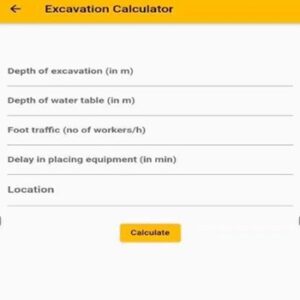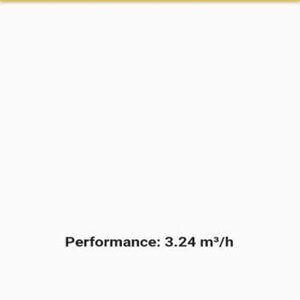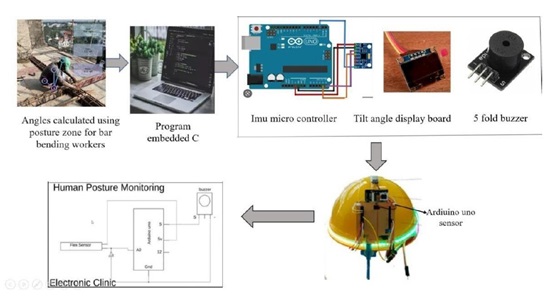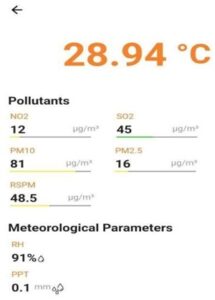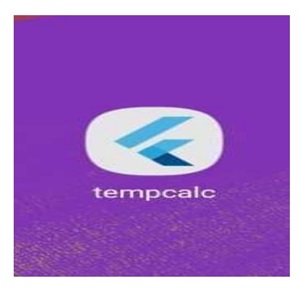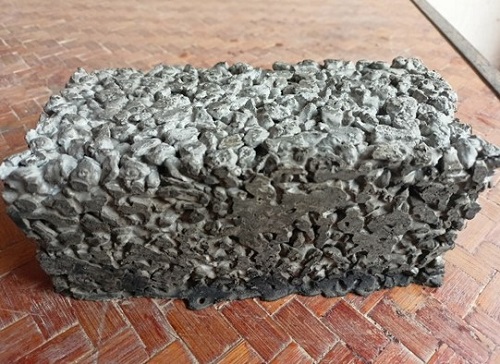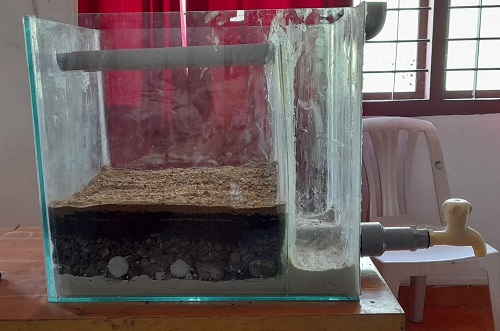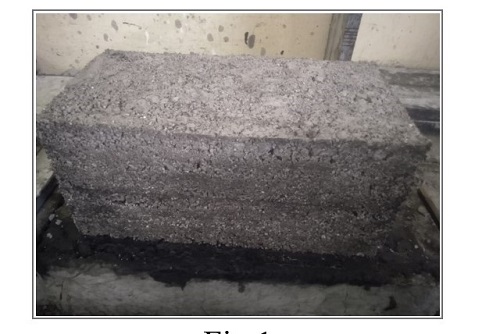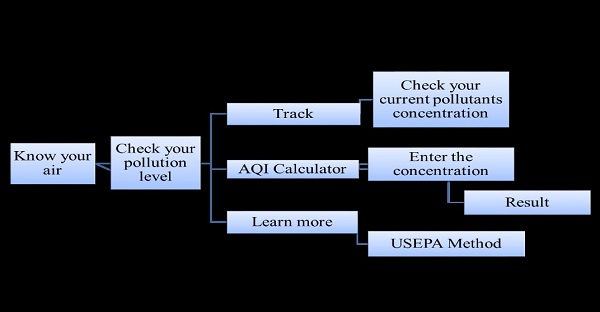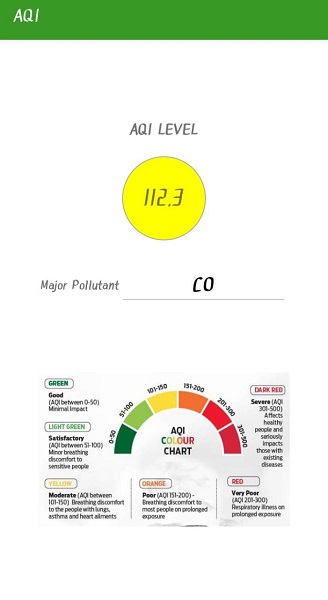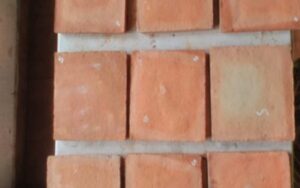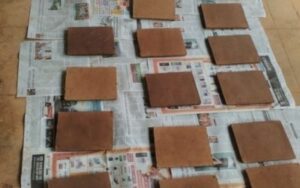Product Development
2022- 2023
Brick with Plastic Waste and C&D Waste
Bricks have been a significant construction and building material for a long time and are widely used around the world. Traditional masonry bricks are made of clay burnt under high temperatures, resulting in high energy consumption, environmental contaminations and decreased natural raw materials. So in order to limit nature risks, inorganic materials such as plastic waste and construction demolished waste can be used to produce bricks. It is estimated that the construction industry generates about 10-12 million tons of construction waste and nearly 300 million tons of plastic wastes annually, which cause a threat to the environment. So the introduction of new technologies to recycle and convert waste into useful materials is crucial for environmental protection and sustainable development. The study deals with an experimental investigation on the use of plastic waste and construction demolished waste in brick manufacturing. The re- utilization of waste materials in brick production can be a successful strategy in terms of less water absorption, waste production reduction as well as decreased clay utilization. This project aims at establishing the optimum percentage of plastic waste in construction demolished waste by adding various percentages of plastic (20%, 25%, 30%) in construction demolished waste based on compressive strength and water absorption property.
A Mobile Application to Analyse Performance of Excavation Equipment
Performance is a numerical measurement of quality of an equipment or process assessed through measurement of physical products and statistical sampling of the output of processes. Excavation equipment are heavy-duty vehicles specifically created for carrying out construction activities, most usually including earthwork operations. Excavators, Backhoe loaders are the most common equipment’s used for excavation in the construction industry. Defects or lapses in the performance of such equipment can lead to increased costs and delays in project completion. This project involves the identification of the factors that affect the performance of excavation equipment in multistorey residential building construction sites. After the identification of these factors, analysis is done and the major factors that affects the performance are ranked. After identifying and ranking the factors, a model is prepared and a mobile application consist of login page, excavation data page, excavation calculator page is developed to examine the performance of excavation equipment.
Equipment for Reducing Ergonomic Risk in Construction Workers
Construction industry is one of the highly risky industries with more number of accident and injuries. The increasing number of injuries caused by repetitive motion, excessive force and awkward postures, ergonomics has become a critical factor in workplace safety. All the employees have a risk of injury when working due to the unawareness with the applicable regulations. Based on the literature, the most significant ergonomic risk aspects are awkward posture in handling job task, force and repetition of specific movement including vibration and noise. Other ergonomics risk aspects includes uncomfortable static position, contact stress of muscles and tendon and also extreme temperature and environment conditions, this increases stress level which is significantly related with musculoskeletal disorders. Among these repetition which involves in doing a task that uses the same muscles over and over with little chance for recovery or working in extreme temperature condition either extremely cold and extremely hot also are the main risk factors. The posturesrelated to the corresponding works is find out by taking their live images during their work using the Software POSTUREZONE. For more accuracy the same worker’s posture from different sides are find out and after that angles obtained is collected for assessing risk using REBA worksheet. REBA is a sensitive tool for assessing abnormalities in all parts of the body (wrists, upper arms, forearms, neck, trunk, and legs). In this project risk is analyzed using work sampling observation area made on workers involved in the task. The hazards are then evaluated using plastering, flooring, reinforcing bar. REBA Score is then developed to describe the posture, repetition of work and the level of risk. In this method ergonomic risk factors are identified based on checklist or score. Based on the assessment an alert system is developed for repetitive task therefore the main causes of injury experienced are identified. It can provide comprehensive results in determining a good work position and it can minimize the risk of work accidents for operators when working.
Mobile Application for Analysing Air Temperature
Temperature variation in the atmosphere is closely related to climatic change, environmental pollution and human health. It has become the prime concern of most countries due to the anthropogenic activities and adverse meteorological situations. This temperature variation depends on various factors like the meteorological parameters as well as the air pollutants. The analysis of temperature variation with these factors are done using Geographically Weighted Regression Modelling (GWR) in Statistical Package for Social Sciences (SPSS). This idea is used to study the chronographic change of relationship between a dependent attribute and one or more independent attribute from the output obtained from GWR modelling in SPSS Software. In this study the variation of air temperature is analyzed with pollutants and meteorological parameters. The study area chosen are Vytila, MG Road, Eloor, Methanam, Kalamasserry. The concentration of NO2, SO2, Respirable suspended particulate matter (RSPM) and the meteorological parameters like Relative humidity, precipitation and atmospheric temperature over 2010-2020 were collected from Kerala pollution control board and meteorological department respectively. A numerical model was developed using the above data to study the variation of temperature in the selected Jareas. Using this numerical model, a mobile application “TEMPCALC” was developed for analyzing air temperature variation.
2021- 2022
Porous Concrete Block using E-waste
Modern scientific and technological advancements have altered the way of living of the common man. Instead of going through the trouble of having an old appliance repaired, most would prefer to get a new one. Such a trend not only leads to an increase in the volume of electronic waste but also poses a serious threat to public health and the environment. Discarded, obsolete, and unusable electronic equipment is known as electronic waste or E-waste. Efforts are made in the construction industry to use the non-biodegradable components of E-waste as a partial replacement for coarse aggregates or fine aggregates in concrete. The major objective of this project is to reduce the accumulation of used and discarded electronic equipment as far as possible. The study was conducted on porous concrete, which is a special variety of concrete with high porosity created from a mixture of cement, coarse aggregates, and water. Mix proportion of porous concrete block was 1:0:2.54. E-plastic waste was used to replace 0%, 10%, 15%, and 20% of the coarse aggregates in porous concrete.
Achievements
Project funded by The Kerala State Council for Science, Technology and Environment (KSCSTE)
Waste Water Filter using Groundnut Shell and Rice Husk to treat Heavy Metals
Wastewater is produced from various sources like households, farms, and industries. Industrial wastewater is produced during the manufacturing process or the cleaning activities related to the process. It is toxic as it contains heavy metals in dissolved form. Wastewater treatment and disposal is a serious issue to look into. Recently, experiments have been conducted to develop simple and environment friendly wastewater treatment methods. In this study, activated rice husk and groundnut shell are used to modify the sand filter to remove the heavy metals from the wastewater. Groundnut shell and rice husk are agro based waste materials which are environment friendly and easily available. Modification of the sand filter was done by partial replacement of sand and gravel. The synthetic wastewater was prepared using heavy metals like cadmium, chromium, copper, iron, lead separately and then passed through both sand filter and modified sand filter to compare the efficiency to remove heavy metals from wastewater. It was found that the efficiency of the modified sand filter was much higher than the conventional sand filter. Therefore, it can be concluded that modified sand filter can be used to remove heavy metals. It was found that agro based waste materials like groundnut shell and rice husk can be effectively used.
Experimental investigation on properties of Lightweight Concrete Blocks incorporated with Cloth pieces.
Million tons of waste clothes are deposited in landfills worldwide. To reduce the pollution caused by waste clothes, they can be incorporated into concrete. This project deals with the experimental investigation of properties of lightweight concrete blocks incorporated with cloth pieces using expanded perlite lightweight aggregate. The materials used in making concrete blocks are cement, fine aggregates, coarse aggregates, expanded perlite, old waste cloth pieces, starch and water. Old clothes originated from the household consumer sector and collected from local tailor shops are utilized for the project. They are shredded into small sizes similar to that of fine aggregate. Starch from food waste is added as a plasticizer, and which also acts as a binder. 400mm x 200mm x 200 mm moulds are used for the casting concrete blocks with cement aggregate ratio of 1:3 and w/c ratio of 0.45. Cloth pieces are added at a rate of 0.25%, 0.50%, 0.75%, and 1.0% by volume of fine aggregate. Coarse aggregates are replaced by expanded perlite by 40% of its volume. The blocks are casted and tested for block density, compressive strength, and water absorption. The results show that all of the specimens fall into the lightweight category. It was observed that at 0.25% addition of cloth pieces, the maximum compressive strength obtained was 1.96 N/mm² and 9.01 N/mm² at 7th day and 28th day respectively. Water absorption increases with increasing cloth content. The cost of a LWCB is high compared to conventional blocks. Since the load is less than conventional blocks, it can be used as partition wall, garden bench etc. Approximate 0.54 kg of cloth waste can be utilized in 1m³ of concrete.
Achievements
Project funded by The Kerala State Council for Science, Technology and Environment (KSCSTE)
2020-2021
Air Quality Index (AQI) Calculator
Air Quality Index (AQI) is a simple and commonly used method to evaluate the overall air pollution of a region. The overall AQI can give clear view about ambient air and the critical pollutant mainly responsible for the quality of air, which can be easier for a common man to understand. Air Quality in various parts of Ernakulam city is being regularly monitored by Kerala State Pollution Control Board. The pollutant’s concentration data were collected and AQIs were calculated to assess the ambient air quality at three selected areas namely Eloor (Industrial), Vyttila (Commercial) and M.G. Road (Residential) areas of Ernakulam city during the year 2018, 2019 & 2020. The AQIs were calculated according to Indian Air quality Index (IND-AQI). The AQI study reveals that particulate matter (PM2.5 & PM10) was mainly responsible for maximum times in all selected areas of Ernakulam city. The AQIs obtained were used to analyse the quality of air before, during and after the lockdown 2020.A web-based AQI app using android software was developed and AQI of the selected areas were analysed. The efficiency of the AQI calculator app was validated by comparing the manually calculated AQI and AQI calculated using the application. The application was developed for quick, simple and an elegant looking response to an AQI online query.
2019-2020
FOOTAP
The students of the 2016 Batch of Civil Engineering Department, under the guidance of Prof. Lathi Karthi, Asst. Prof. Anju Paul, Asst. Prof. Sahimol Eldhose and Asst. Prof. Vidya Jose installed a FOOTAP (Foot Operated Tap) in the Canteen where there is an extensive chance of pandemics to flare-up. Though it was taken as a precautionary measure to break the spread of the infectious coronavirus, the Footap had also contributed to the reduction in wastage of water. FOOTAP consists of a table-mounted spout, pedal, and valve. The operation of this foot valve occurs by pressing leg-controlled pedals instead of hands and the water comes from the spout installed on the basin. This is a no-touch cost-effective solution. It can be installed in any public offices and the cost is around Rs1500/-. The system is characterized by its simplicity, ease of installation, and maintenance besides its low effective cost.
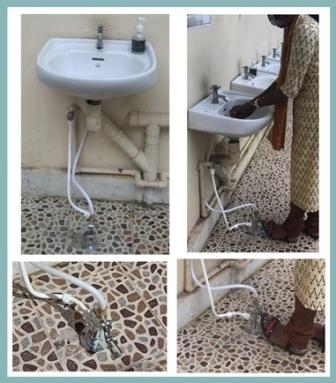
This is a mobile application that has been developed to evaluate the cost overrun in Kerala based construction project. The app can be used to evaluate the unexpected incurred cost or the costs that are in excess of the budgeted amount. It is a software package designed specifically for Android development. Android Studio’s job is to provide the interface to create apps and to handle much of the complicated file-management behind the scenes. The programming language used was Java and this will be installed separately on the machine. Android Studio is simply where we can write, edit and save the projects and the files that comprise different projects. The Java code allows running smoothly on Android devices and takes advantage of the native hardware. Java is needed to write the programs, the Android SDK is needed to make those programs run on Android and Android Studio has the job of putting it all together. At the same time, Android Studio also enables to run codes, either through an emulator or through a piece of hardware connected to your machine. With the help of this app we can predict the cost overrun in Kerala based construction project and thereby we can reduce the financial difficulty during construction.
Sustainable Floor Tile
Floor tiles made of clay, laterite and silica fume has been developed which shows an increase in UCC strength and water absorption. This tile can be used as a replacement to conventional floor tiles.


